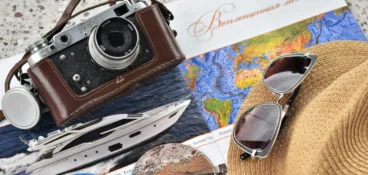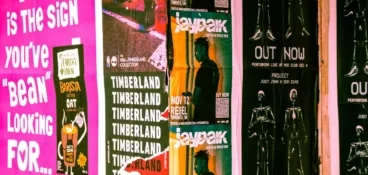If you think travel brochures are a thing of the past, you’re wrong. A survey by Bentley University showed that 79% of visitors pick up a travel brochure while on vacation. And 73% of them would consider changing their travel plans because of a brochure.
The short of it? Brochures still pack a big punch for companies in the travel and leisure industry. And while there’s no denying that print has its downsides (costly typos, environmental concerns, difficult-to-track metrics), the payoff is clearly worth it.
So, I’m breaking down how to make a travel brochure that will make your audience grab their passports and jump on a plane.
Less review rounds, better designs
Get quick and clear feedback right on top of your designs with Filestage.
Step one – Define your target audience
Everybody loves a vacation, but chances are your tourist brochure is trying to target a specific audience. Different travel destinations attract different travelers.
I mean, you’ll create a very different brochure for a group of twenty-somethings hitting Ibiza for a week of clubbing than for a family of four heading to Florida for their summer break.
The first step when creating travel brochures is to understand who you’re speaking to. Here’s how to do that:
- Identify your ideal customer – What are their interests? Travel preferences? Pain points? Are they luxury travelers or budget backpackers?
- Define your destination – How does your location align with your target audience’s desires? What is your destination’s unique selling point?
- Find your message – How can you make a travel brochure that resonates with your ideal customer? Are they interested in “family fun” or “historical landmarks”?
Example
This brochure by Contiki is a top example. It knows its target market is young backpackers who want high thrills for low prices.
The design, imagery, and travel destinations all reflect Contiki’s ideal audience.

Source: travelbrochures.com
Step two – Do your research
This may seem like a no-brainer, but most tourist brochures fail because they just don’t provide the right information.
Avoid this pitfall by doing deep research into your destination (from the perspective of your target audience.
Your research should include:
- The history, customs, and culture of the location
- Top attractions (including price and recommended tour operators)
- Transportation
- Dining out options
- Practical information about the local time zones, language, and currency
A thorough competitor analysis can help you with this step. Take time to review travel brochure examples for similar destinations, identifying any gaps in your content and best practices to follow.
Example
This Singapore travel brochure is a masterclass in doing proper research. There’s essential information about the culture as well as practical information about when to visit.

And if you flip it over, you’ll see it includes everything travelers need to know about the country, including a map, itinerary, and pricing information.

Source: Behance
Step three – Create a concept
Now you know who you’re marketing your travel brochure to and what they want to see, it’s time to create your concept.
Your brochure should tell your audience a story and make them want to book a trip. Here are some ways you can achieve this:
- Set a clear goal and purpose for your brochure – Do you want to generate bookings? Inspire audiences to book a trip? Provide high-value information?
- Create a central theme to capture the essence of your travel destination – Is it about discovering an ancient culture? Reconnecting in nature? Making memories with the kids?
- Define a design that best tells your story and resonates with your readers – Is there a clear hierarchy of visual elements? Do you have high-quality photos to sell your destination?
- Incorporate interactive elements – Would embedded images or QR codes add more value for your reader? Or would they prefer a more traditional approach?
These brochure design ideas will show you what’s possible.
If you’re not a designer, try using a template. Brochure design software like Adobe or Canva have a host of free templates, created by designers. That way, you can be confident in the layout and design of your travel brochure. All you have to do is customize it with your company’s branding.
For more tips, check out our guide on how to make a brochure.
Example
I love this travel brochure template from Venngage because it’s cohesive and it tells a story: the American Southwest is the ideal travel spot for adventure seekers who love nature.
Everything from the layout to the color palette to the choice of images works together. Chefs kiss 😙🤌

Source: Venngage
Step four – Apply color psychology
Color tells a story. That’s why it’s so important to get your color palette right. For instance, if you’re selling a tropical paradise, you’ll most likely use bright blues and yellows. A nature destination will probably have a lot of greens and browns.
You get it, the idea is to choose a color story that reflects the atmosphere of the place you’re selling. Browse these travel ads for ideas on what color palettes work.
Here are some other points to consider:
- Keep your color scheme consistent throughout the brochure
- Use accent colors to make key information easier to read
- Create a color palette that evokes emotion
- Be aware of the cultural connotations associated with certain colors
Example
This free template from Adobe Express uses just the right amount of color. It cleverly chooses a dusky orange and white palette that complements the colors of the tiger. Sometimes simplicity has the biggest impact.

Source: Adobe Express
Step five – Make the copy “poppy”
Images are usually the bread and butter of a great travel brochure. But that doesn’t mean you should ignore the copy.
Clear and persuasive copy will grab your audience and give them access to the information they need. Need inspiration? Read my list of the best slogans of all time (all from the travel industry).
Here are some “poppy copy” tips:
- Your headline sets the tone and tells readers what your brochure is about – so get it right
- Don’t overdo it on the adjectives or fluffy language – your readers don’t want to work that hard to get the key information
- Only include essential details and cut the rest
- Break copy up into small sections with relevant headings
- Be consistent with your tone of voice
- Make CTAs clear
Example
Less is more. And the copy in this Swiss travel brochure proves it.

Source: Behance
Step six – Build a proper review process
A proper creative review process makes it easy for you to share designs across different teams and gather feedback in a centralized platform. The same is true whether you’re making a product catalog, ad campaign, or – in this case – a travel brochure.
To do this effectively, you need online proofing software.
Tools like Filestage streamline the interview review process so you can:
- Share assets across multiple teams and departments
- Gather in-context feedback directly on assets (in one place)
- Make sure your travel brochure is reviewed by the right team members
- Reduce the time wasted sharing feedback via email
Example
This is how simple your content review workflow can be with Filestage:
- Set up your workflow – our team will help you build a custom review workflow and turn it into a template for future projects
- Create custom reviewer groups – decide which teams or departments need to review assets and when
- Upload your assets – upload your travel assets (or use our Google integration to auto-import files)
- Automate the process – set up send automatic deadline reminders to keep projects on track
- Easily visualize changes – our AI auto-compare tool flags changes so you can see what’s new after each review round
- Maintain a clear audit – centralize all feedback and asset versions for easy bookkeeping

How to make a travel brochure: 6 best practices to follow
Follow these best practices to create a travel brochure that wins the hearts (and wallets) of your audience.
- Be consistent with your messaging, design choices, and copy – everything should reflect your brand and be tailored to your ideal reader
- Experiment with different layouts, headlines, and copywriting techniques – then test to see what works
- Don’t forget the fold – make sure the most information is visible when you fold the brochure
- Use white space to improve the readability and visual appeal – strike the right balance between text and images
- Prioritize cultural sensitivity – research local customs and traditions to avoid offensive messaging
- Think about sustainability – opt for sustainable materials to lower your environmental impact
Travel brochure FAQs
What is a travel brochure?
A travel brochure is a printed or digital guide designed to promote a destination or attraction. It typically includes high-quality images of the destination and all the necessary details travelers need to plan their trip.
What should a travel brochure include?
The content of your travel brochure will depend on the destination or attraction you’re promoting and the audience you’re talking to.
That said, here are the core elements every good travel brochure should include:
- High quality imagery of the destination’s top attractions
- Details about the location, things to do, accommodation, and restaurant recommendations
- Interesting information about the local culture and traditions
- Practical details for planning a great trip like maps, itineraries, and booking information for tour operators
- Your brand logo and contact details
- A clear (and persuasive) call to action
In terms of style, incorporating a captivating title section, a cohesive color scheme, and clear sections will enhance readability.
What software do I need to make a travel brochure?
These tools will help you to make a travel brochure that grabs your audience’s attention:
- Design software – Design tools like Adobe Express, Canva, and Visme are perfect for beginners. More advanced designers may want to opt for Adobe InDesign.
- Online proofing software – A proofing tool like Filestage is ideal for reviewing your travel brochure and leaving feedback directly on artwork
- Interactive tools – Tools like FlipHTML5 can turn a simple PDF into an interactive digital travel brochure with sound, video, and zoom functionality
What is the standard travel brochure size?
If you’re using a travel brochure template, the most common size is 11” x 8.5” (these are the dimensions of printed letter paper). That said, you can customize your travel brochure to suit your audience and content.
Less review rounds, better designs
Get quick and clear feedback right on top of your designs with Filestage.
Next steps
Travel brochures aren’t just a throw-back to the good ol’ days. Over half of travelers find them trustworthy and printed brochures have an average distribution reach of 3.5 readers per brochure (Source: Bentley University).
The value is undeniable. But there are some challenges when making travel brochures. Namely, typos or content changes can be costly to fix. This is why implementing a review workflow is a must.
Online proofing software allows you to build a structured approval process for travel brochures and other promotional materials. That way, you can easily review assets between multiple teams and leave precise feedback on artwork.
Start a free seven-day Filestage trial to see how you can review travel assets with your team faster.





